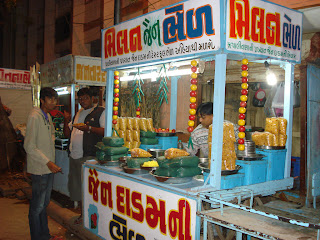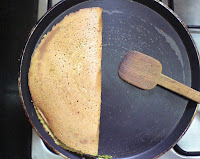Embarking on a food journey on Indian streets, the writer tries to analyse what makes roadside food off a cart one of the most sought after items on a to-do list
 |
| Yummilicious chana chat |
 |
| Hot off the fryer - samosas! |
 |
| The famous Palitana bhel stall. Photo by Hardik Patel |
The selling point of the street food carts, besides being quick, affordable and at most times totally mouthwatering, is the fact that they know how to be innovative to please the crowd. This innovation has given birth to some of the most loved dishes of all time – like the Chinese bhel, the chop suey dosa, the samosa sandwich and the Chinese vada pav! In fact, it is quite likely that your neighbourhood tapri will offer you lemon tea without milk or sugar, green tea, masala tea, mint tea, milk tea, not to mention the humble cutting poured out into the special cutting glass out of a battered aluminium kettle.
It’s not only about the variety on the menu, it is also about the way things sell. From full meals to simple snacks and fast refreshers, the street vendors have it all at a go. They do not have to ask for the permission of a manager to make substitutions in food, to hand over two extra bhajiyas in lieu of two bucks change, or to give an extra helping of onions or pickle or any other condiment to the customer. The decision is fast, and timely, and revolves around keeping the customer happy. Sometimes one could wonder that the business skills that life has taught these inventive street cooks-cum-entrepreneurs could be equated to those learnt at B-school. I’m sure they could. And in some cases, the street-smart food guys will emerge on top. Which B-school teaches students to deal with haftas to be given to the local police and goons alike, just for basic survival?
 |
| Mumbai's famous - pav bhaji! Photo by Ashish Lakhara |
As acclaimed photographer Sephi Bergson, who has been tracking down the best street food in the country, combining the vibrant and colours and mouthwatering sights in the pictures, puts in her book Street Food of India, “From the teeming lanes of Old Delhi to the hot, dusty streets in the remote countryside, it is painfully hard to resist the smells and sights and tastes of this roadside food, prepared in front of customers’ eyes with the freshest ingredients and a good helping of panache and showmanship.”
A lot has been written about these innovative entrepreneurs, special cook books have been devoted to them, and every home cook has tried to replicate the tastes in a clean home kitchen. To the despair of those digging into the fare, even the most able cooks have failed to produce the dishes that match up. The taste, as many say, lies in the huge amount of effort that the roadside cooks put in to feed an army of people day in and day out, coupled with the survival instincts needed to combat competition, to stay clear of the local ‘dons’ and the hawaldars, and last but not the least, the sultry weather. Whatever be the case – sweltering heat, an untimely downpour or a gusty wind, a starving stomach, or even a hungry eye will not be deprived of the intense sights, smells and tastes of street food.
 |
| Sizzling tikkis. Photo by Jim Elliman |
There is so much passion for roadside food in India, that families and friends make special plans to go out and eat at their favourite cart, just like families plan to go dining at their favourite restaurant. “Nothing can beat the sizzling sounds of that fried tikki or bhature with the irresistible fragrance of stunningly garnished chholas and pickles spiced up with green chillies and onions,” says writer Nitin Pahuja in a post about Delhi’s street food. It may sound like the dieter’s worst nightmare coming true, but foodies will do anything for these spicy treats.
“There was a time when we used to drive all the way from Mumbai to Khopoli for just that one vada pav from a special vendor out there. At that time, there were not as many road side eateries as we have now,” reminisces food lover Ruchir Sheth of his college days, a high, which he is sad that his (spoilt) children will never experience. Those were times when parents were hoodwinked to obtain cars for long rides, speedometers were taken off so that the kilometres were not added, and cars were zoomed off by this group of friends for just one large juicy bite that encompasses the fried spicy potato filling coated with mild chickpea batter, the garlicky powder chutney that added the extra zing, and the humble pav that cut through all the pungency. Now, that, is what we can call capturing the taste.
Any piece where we talk of street food as a delicacy in the cities (well, for some, due to several reasons, it would be staple), would be incomplete without a little mention of the dhabas on highways across the country. When Rocky Singh and Mayur Sharma chronicled their unusual, unexpected and unknown eating at some of the most popular dhabas in a popular national daily, it was as if a food lover’s eyes were gleaming at the prospect of a delicious meal. No wonder, after tasting over 2000 dishes at more than 600 eateries they say “If you take the foods of the world on one side and the foods of India on another, our pile would easily tilt the scales.”
“There was a time when we used to drive all the way from Mumbai to Khopoli for just that one vada pav from a special vendor out there. At that time, there were not as many road side eateries as we have now,” reminisces food lover Ruchir Sheth of his college days, a high, which he is sad that his (spoilt) children will never experience. Those were times when parents were hoodwinked to obtain cars for long rides, speedometers were taken off so that the kilometres were not added, and cars were zoomed off by this group of friends for just one large juicy bite that encompasses the fried spicy potato filling coated with mild chickpea batter, the garlicky powder chutney that added the extra zing, and the humble pav that cut through all the pungency. Now, that, is what we can call capturing the taste.
Any piece where we talk of street food as a delicacy in the cities (well, for some, due to several reasons, it would be staple), would be incomplete without a little mention of the dhabas on highways across the country. When Rocky Singh and Mayur Sharma chronicled their unusual, unexpected and unknown eating at some of the most popular dhabas in a popular national daily, it was as if a food lover’s eyes were gleaming at the prospect of a delicious meal. No wonder, after tasting over 2000 dishes at more than 600 eateries they say “If you take the foods of the world on one side and the foods of India on another, our pile would easily tilt the scales.”
 |
| Dinner polished off at a dhaba. The lassi is arriving! |








